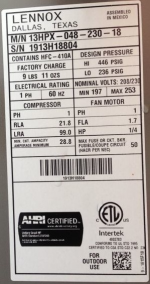Grouch
Senior Member
- Location
- New York, NY
Hi all,
I haven't been on here in some time!
Kind of a basic question: usually when I see the mechanical / HVAC schedules on a set of mechanical drawings, I'll see an AC unit (for example) with a voltage rating of 208 / 230 volts. I understand it is saying the AC unit is compatible with both voltages. However, the 230 volt rating... is it really a 240 volt rating, and they show 230 volts to take into account voltage drop? If that's the case, how come they don't show something less than 208 volts? If 230 volts is shown to account for voltage drop from a 240 volt system, why not show 200 volts to account for voltage drop as well in a 208 volt system? It's as if voltage drop is accounted for in one system, but not the other. Unless I'm interpreting this wrong.
Thanks!
I haven't been on here in some time!
Kind of a basic question: usually when I see the mechanical / HVAC schedules on a set of mechanical drawings, I'll see an AC unit (for example) with a voltage rating of 208 / 230 volts. I understand it is saying the AC unit is compatible with both voltages. However, the 230 volt rating... is it really a 240 volt rating, and they show 230 volts to take into account voltage drop? If that's the case, how come they don't show something less than 208 volts? If 230 volts is shown to account for voltage drop from a 240 volt system, why not show 200 volts to account for voltage drop as well in a 208 volt system? It's as if voltage drop is accounted for in one system, but not the other. Unless I'm interpreting this wrong.
Thanks!

